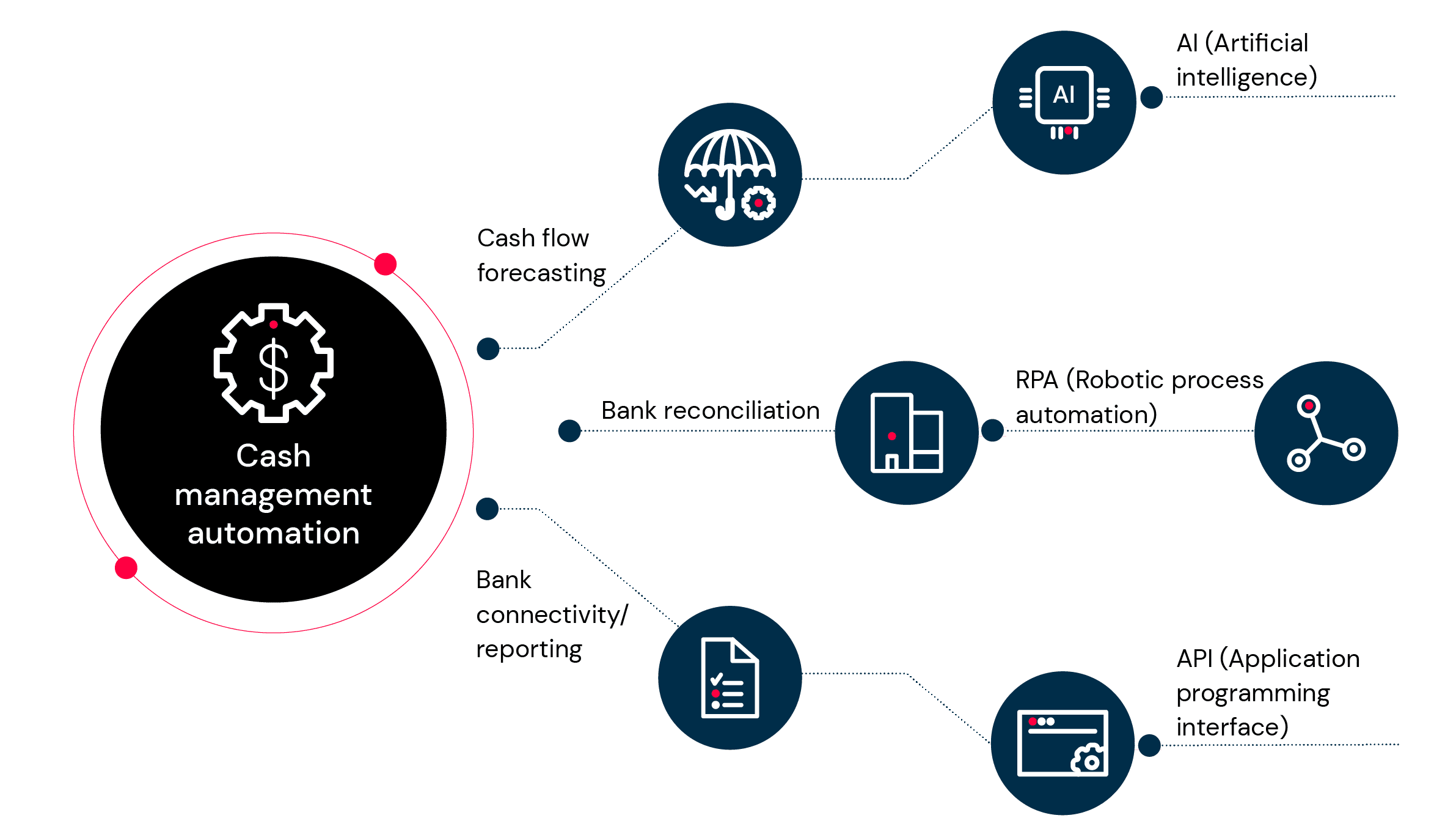Cash management is one of the core functions of treasury. In simple terms, it means the process of collecting and managing cash flows to ensure optimum liquidity and maximized returns for business.
Cash visibility: Emerging technology trends for 2022 and beyond
Cash management is one of the core functions of treasury. In simple terms, it means the process of collecting and managing cash flows to ensure optimum liquidity and maximized returns for business.
However, many organizations are yet to comprehend its significance due to which their treasuries fail to benefit from effective cash management. The reasons could be varied: poor understanding of cash conversion cycle, ineffective and disjointed banking structures, lack of global cash visibility and such. Improving cash visibility is perhaps one of the top-most priorities for treasurers today. More so, with the crisis following the pandemic, when organizations witnessed their cash resources getting hit hard. As market liquidity weakened, it became more a question of survival with only internally generated cash.
As organizations chart their path to recovery post pandemic, following a set of best practices (for both processes and technology) that ensure prudent cash/liquidity management, is treasury’s prime agenda in 2022.
What are the top tech trends in treasury digitization we see emerging this year
Treasuries need a single point of visibility over their global cash position to be able to make judicious financial decisions. A 360-degree, transparent cash visibility will lead to accurate and reliable cash forecasting, quick reporting and optimal working capital utilization. Though it’s a necessity, it’s not easily accomplished and remains an ongoing challenge for most treasurers worldwide. That said, treasurers today have more access to some of the best technology available to mitigate these challenges.
Treasury digitization
A. Cash management processes – for better cash visibility
Treasury digitalization is key to opening up a plethora of opportunities for treasurers.
Traditionally, treasurers faced significant challenges across tedious and manual processes, limited cash visibility, compromised security, non-integrated systems and departments – stumbling blocks that can be addressed successfully by digitalization. Businesses that empower themselves with cloud-driven, centralized and holistic solutions, stand to gain better visibility and control over cash resources.
While the extent of digitizing cash management function will depend upon the organization’s size and degree of treasury centralization, here are few of the top emerging technology trends for automation of three most important sub functions in cash management:

1. Cash flow forecasting
Cash flow forecasting is one of the most essential treasury processes. Accurate forecasts help accelerate growth and improve the bottom line by enabling treasurers to make sound, strategic financial and investment decisions. Additionally, with the high volume of global transactions/payments, it’s necessary to have a robust automated cash flow forecasting tool that provides treasurers with real-time and an accurate, single view of cash on demand.
Implementing Artificial Intelligence (AI): AI has revolutionized cash flow forecasting and cash visibility in turn. Several aspects of AI-driven technologies are being leveraged in platforms to facilitate intuitive interactions with data. At the forefront are Machine Learning (ML) models that leverage historical data to predict future cash flows. One of its main components is finding an appropriate ML algorithm with the lowest probability of error out of many available for instance: ARIMA, CNN-QR, Deep-AR, ETS, NPTS, Prophet and such. For cash forecasting, the process begins with entering historical data into the model, grouping of inflows and outflows at a more granular level and investigating data outliers. Models are trained via algorithms that apply rules and run the tests. Finally, model results (forecasts) are compared with the actual manual results, to test its efficacy.
2. Bank Reconciliation
Bank reconciliation is an indispensable financial control tool that not only highlights fraudulent activities but also helps ensure that the cash shown in the company’s ledger is actually available in the bank account. For treasurers using spreadsheets for bank reconciliation, it is an arduous task, with a low probability of 100% accuracy considering the volumes of bank accounts and types, multiple branches/payment types and complexities/time zones/disconnected systems/no real-time information.
Implementing Robotic Process Automation (RPA) – Spreadsheet macros are limited in capability as they neither offer scalability nor end-to-end straight through processing. Juxtapose this with RPA that leverage an intelligent document processing solution with inbuilt cognitive capabilities such as OCR, RPA, and AI. These technologies are built to analyze large volumes of data and automate repetitive tasks accurately with zero errors. Essentially, an RPA works by extracting relevant documents and then matches data at a transaction level to identify mismatches or discrepancies. It then investigates the reconciling items and fixes errors. It results in speed, accuracy and better cash visibility for treasurers on a real-time basis.
3. Bank Connectivity and Cash/Bank Balance Reporting
Accessing multiple bank accounts for geographically dispersed entities is a tiresome and manual process for treasurers. Not having automated real time bank connectivity could mean loss of 360-degree cash visibility. Also, not having clean cash visibility could mean delayed or inaccurate cash reporting, both to internal and external stakeholders.
Implementing Application programming interface (API’s) – APIs essentially allow two computer applications to talk to each other over a network, using a common language. With APIs, multiple banks can be connected in real time with treasury’s ERP/TMS system, thus facilitating 360-degree connectivity and fast data exchange.
APIs not only help convert batch processing into real-time processing but can also bring in huge benefits in terms of – enhanced speed, reduction in human errors, scalability to manage large volumes, real-time alerts and more. Treasurers are empowered to take quick cash management decisions due to better cash visibility with receipts/payment data available in real-time. With APIs, banks can also feed real-time key insights and analytics into ERP systems, thereby eliminating manual data analysis for treasurers.
With the adoption of PSD2 in Europe, APIs will play a significant role in future too. APIs can also convert weekly/monthly reporting into real-time reporting. While BAI or MT reporting forces treasurers to search bank portals for continuous updates, APIs can offer instant reporting on Ebam processes and payments.
B. Cloud computing and no-code and low-code
Another key emerging technology trend in 2022 are no-code and low-code platforms. Low code platforms enable users to design and create applications with little to no code, allowing non-developers to build their own business applications. Cloud computing helped accelerate the recent low-code explosion. Treasurers will now no longer only recommend solutions, but be the ones developing them as their business requirements evolve.
Forrester Research predicts that in 2021, 75% of application development would be on low-code platforms and in 2022, there will be a 15% rise in the low code market. Cloud computing seems to be the perfect complement to low-code development. While low code is expected to provide enhanced productivity, cost savings, and quicker development, cloud computing essentially delivers similar benefits for deployment, especially for virtual teams. Cloud computing and low code go hand in hand to provide both agility and scalability. A fast-growing treasury must include both cloud and low code in its future technology strategy.
C. Real time cash flow dashboard
One of the advanced tools available to treasurers today is a real time customizable cash flow dashboard. The inbuilt DIY capability allows treasurers to derive key business insights by creating intuitive visualizations on their own, with interactive feed/reports – thus, enabling real time cash visibility.
Conclusion
Implementing suitable technology to empower treasury could be a complete game changer for an organization. Successfully harnessing the power of API, AI, RPA, Cloud Computing, No-Code, Low-Code, DIY and customizable dashboards could really prove to be the step forward needed in the direction of enabling real time cash visibility for treasurers. It would also promote agile and fast decision making, thereby enabling treasurers keep up as the expectations from their role evolves.
Other resources

Global cash visibility becomes more critical than ever to build a real-time treasury
The old adage ‘Cash is king’ is probably losing its significance fast in the post-pandemic world as treasurers worldwide scramble to gain a clean, transparent and more accurate understanding of their cash positions globally.

Driving real time visibility and control for an agile treasury: Real time cash flow dashboard
As per GTreasury 2021 Cash Forecasting & Visibility Survey Report, the majority of treasurers are seeking global cash positions that can update on a real-time or intraday basis, but many report being stuck with weekly (or less frequent) updates.

The old adage ‘Cash is king’ is probably losing its significance fast in the post-pandemic world as treasurers worldwide scramble to gain a clean, transparent and more accurate understanding of their cash positions globally.

As per GTreasury 2021 Cash Forecasting & Visibility Survey Report, the majority of treasurers are seeking global cash positions that can update on a real-time or intraday basis, but many report being stuck with weekly (or less frequent) updates.